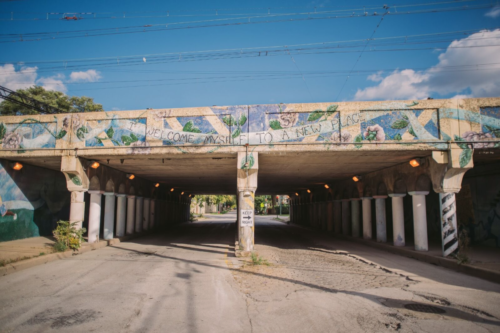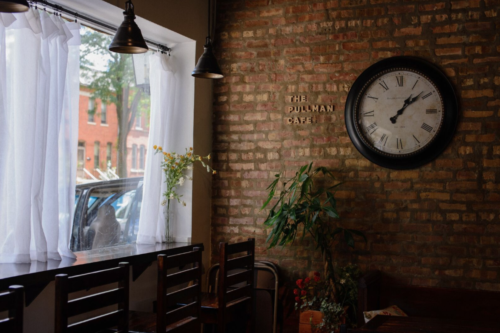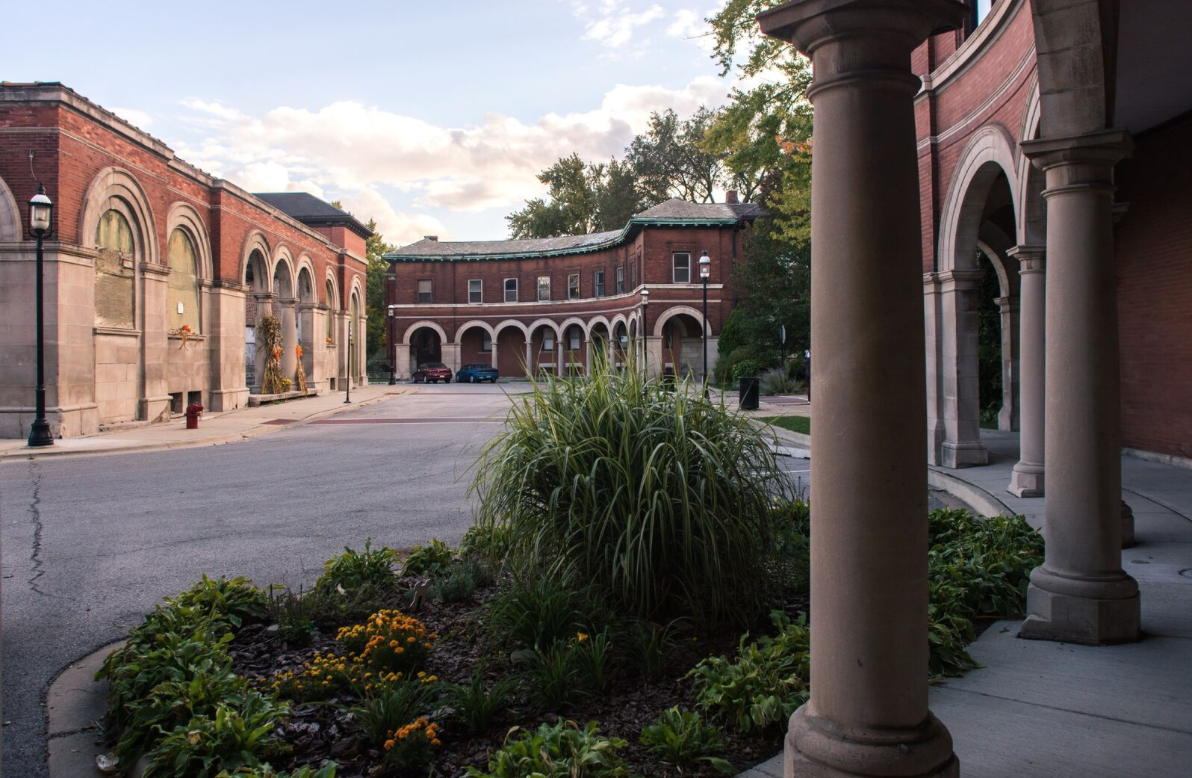- • Best Site-Specific Art Project
- • Best Alternative History
- • Best Place to Feel at Home
- • Best Weekend Soul Food
- • Best Use of Salvage Material
In 1881, George Pullman chose Chicago to hold “the World’s Most Perfect Town.” Because of his earlier experiences in the city, he believed that the Chicago spirit he so admired would imbue his new town with the same optimism. He believed that the overall design and the amenities provided to Pullman residents would elevate the common worker, inspiring the laborers to pursue their own self-betterment. That spirit of optimism never seemed to fade, through bitter strikes, wars, racial tensions, and economic downturns.
People have come here seeking a community and a home for over 130 years, first to the town of Pullman and then to the Pullman neighborhood. Until 1950, the percentage of foreign-born residents was five times the national average. Pullman still maintains this hopeful sense of community, as one of the few Chicago neighborhoods that is truly integrated, with an active LGBTQ community as well.
Residents here feel a strong connection to the rich history of the area. In a way, the past helps bring us together, through events like the annual House Tour and the many educational lectures and programs that take place throughout the year. The Pullman area was threatened with Urban Renewal in 1960, spurring residents to form the Pullman Civic Organization. These organizations, meetings, and events have in turn led residents to form several social clubs, such as the Garden Club and the Bridge Club.
Solon Beman, the original architect of the town of Pullman, designed the structures and the whole layout of the town with an eye towards aesthetics, an appreciation of art that carries through to today. The neighborhood is home to many artists and boasts a gallery, a choir, and a dance troupe. This artistic focus will soon be strengthened—the Pullman Arts group is working with Chicago Neighborhood Initatives and Minneapolis-based ArtSpace, Inc. to create live/work spaces in two Pullman block houses along with new construction.
The Pullman company has been out of business since the 1980s; indeed, the whole industrial corridor along Chicago’s Far South Side has lost most of its industries and jobs. Yet the only new industry that has been built recently in Chicago, the Method soap factory, was built in Pullman. The hope, promise, and inherent strength that our neighborhoods exhibit have caused developers to look to the Far South Side as a place of new business. Pullman also has welcomed Gotham Greens, the world’s largest commercial greenhouse, and will soon be welcoming a Whole Foods distribution center and warehouse.
Our greater community includes the surrounding neighborhoods of Roseland and Kensington, both of which have experienced economic downturn and hardship. Many of the area’s current residents are looking toward a new horizon as we, together, form the larger picture of the Pullman National Monument. To us, the monument that President Obama created in 2015 serves not just as a recognition of our past but as a celebration of our future. In this spirit, the three communities continue to form a common bond for their future well-being, working together to make our part of the world a better place.
Andrew Bullen is a Pullman resident and amateur Pullman historian. His work in Pullman, besides the restoration of his residence, includes the Pullman House History Project and the Pullman State Historic Site’s web presence at pullman-museum.org.
Best Site-Specific Art Project
LaborPaste, mosnart
As people walk through Pullman’s Victorian row houses, they might suddenly spot a black-and-white photo of Harriet Tubman by a door, Frederick Douglass in a window, or Eugene Debs waving his hat to the crowd. They don’t know when they’re going to stumble on an iconic image of Dolores Huerta holding aloft a “huelga” sign during the California grape strikes of the 1960s in a third-story window. The unexpected cutout photos evoke the rich history of the former company town—its path from utopian beginnings to state-sanctioned violence that led to thirty deaths nationwide after striking workers stood up to their industrial landlord George Pullman. The life-sized photographs wheatpasted around the neighborhood, like the Pullman porter carrying a suitcase across a garage door at 111th and Champlain, confront pedestrians with the past and the ongoing struggle for progress.
J.B. Daniel’s “LaborPaste” installation, woven into the streetscape, encourages wandering and discovery. There are no explanatory labels, just the starkness of historical pictures that ignite viewers’ curiosity.
Another current installation hearkening back to history, “Community,” is interactive. Located on a wall of the old Arcade building, it invites passersby to chalk artistic answers to the question “What is your vision of a contemporary utopian community?” In July, a multicolored geometric “I MAKE MY FUTURE” blazed; in late August, the first three letters of “Opportunity” formed the eyes and nose of an eager, blue-and-orange face.
These works exist alongside Daniel’s broader installation project, “mosnart,” which brings in visiting artists to work within the neighborhood’s historical and architectural constraints, resulting in pieces like Matthew Hoffman’s massive “Go For It” and, most recently, Seattle-based Sherri Gamble’s “Hand-held,” for which she cast the hands of more than sixty residents.
“The ‘Go For It’ installation was definitely the most fun,” Daniel said. “We built it in the old Pullman Factory with lots of neighbors helping. We wheeled it through the streets to its current home in Market Square. It continues to generate positive meaning for both the community and individuals.”
Daniel named the project mosnart—“transom” spelled backwards—because most installations begin on the transom above the front door, but also to further an “idea of art and community flowing back and forth across a threshold.”
“It might be that in doing what we’ve done for the past eight years, we have created some possibility that wasn’t here before,” he said. “That’s all I’ve ever wanted any of my art or art projects to do.” (Joseph S. Pete)
mosnart, transom installations, 11319 S. St. Lawrence Ave. tallskinny.com/mosnart
LaborPaste, jbdaniel.com

Best Alternative History
A. Philip Randolph Pullman Porter Museum
Inside a beautiful turn-of-the-century brick row house on 104th and Maryland, you’ll find the A. Philip Randolph Pullman Porter Museum. Though about ten blocks away from the heart of the neighborhood, the story the museum tells is essential to understanding the full history of Pullman. Founded in 1995, the Porter Museum is the only independently operated museum within the Pullman National Monument, receiving no government funding. The museum details how Randolph founded and led the Brotherhood of Sleeping Car Porters (BSCP), an African-American union (the nation’s first) that confronted the Pullman Company for better wages and working conditions. It took ten years of organized protest for the Pullman Company to even recognize the union as legitimate. As you wind your way down the three stories of narrow galleries to the music of Louis Armstrong, you see the artifacts of that struggle for recognition, from photos of union leaders planning marches to a letter from a field organizer decrying the discrimination faced by Brotherhood members. This is a story that contrasts sharply with the usual historical narrative about Pullman, a story of the innovations both in the Pullman Company’s train car designs and urban planning strategies. (At the Historic Pullman Visitor Center, just one trifold piece of cardboard sits on display to inform visitors about the union.)
While this inequality in historical emphasis is a source of neighborhood tension in its own right, it feeds into a larger fear that the African-American community of northern Pullman, Roseland, and Rosemoor might be left behind as Pullman receives renewed national and local attention. The Porter Museum fills a vital space by offering programming that grapples with how black history can be a tool to address current neighborhood issues. A new radio talk show called Live from the Pullman National Monument, hosted by museum founder Lyn Hughes, focuses on how the rich history of the BSCP can be leveraged to bring tourism benefits to the African-American community. The Pullman Messenger magazine is another new endeavor Hughes founded in collaboration with the museum; it’s named after The Messenger, the political and literary magazine in which A. Philip Randolph first wrote of the need for an independent union. Its mission statement—“to highlight ALL of the Pullman community’s businesses, tourist sites, activities and events”—positions the magazine to develop the black community’s own narrative about what makes Pullman so remarkable, as well as to “take back control of your community and not allow planning to take place that could result in plans being developed that don’t include you.”
Consider these developments along with the city’s plan to redesign the 111th Street Metra station as a Pullman train car. Those renovations make history a light-hearted experience for the incoming tourist: you look, you enjoy, and then you leave. But the Porter Museum engages history in such a powerful way precisely because it prompts debate and discussion about the future of the community, rather than simply showcasing the pleasing elements of Pullman’s past. (Robert Hayes)
National A. Philip Randolph Pullman Porter Museum, 10406 S. Maryland Ave. Open seasonally, April–December 1. Thursday–Saturday, 11am–4pm. $5. (773) 850-8580. aprpullmanportermuseum.org
Best Place to Feel at Home
Pullman Café

The visitor to the Pullman Café is greeted with at least two different welcome signs, wooden furniture handmade by the owner’s aunt, and friends chatting amongst homey décor, a mix of exposed brick and cozy cushions. It’s an atmosphere of calm conviviality. Since its opening last October, the café has become something of a community hub, hosting book signings, Jazz Society performances, and Cooperation Operation open mics, while also drawing groups from all over the city; DePaul University, for example, chose the café as its venue for a lecture on entrepreneurship and community. Still, what sticks is an air of small-town intimacy; if you show up on the weekend, you’ll likely be greeted by the owner, Ian Lantz, who wears a “Pullman Strong” bracelet, can spout a wealth of information about the neighborhood, and will insist upon showing you the Alley Art Walk out back. Lantz sees the café as a forerunner of future development in Pullman and Roseland, opening it up to artists and creative types who will bring their own projects to the Far South Side. Meanwhile, the community space serves as a warm environment to meet friends, eat pizza off of log serving platters, or play the board game Class Struggle. If you’re looking for a place to buy delicious homemade lemon bars, salads with locally grown Gotham Greens, or just a bag of Funyuns, keep in mind what Lantz assured a departing patron: “You’re always welcome here.” (Anna Christensen)
Pullman Café, 11208 S. St. Lawrence Ave. Tuesday–Friday, 10am–7pm; Saturday, 10am–5pm; Sunday, 10am–3pm. (773) 828-8338. thepullmancafe.com
Best Weekend Soul Food
Corliss Cozy Corner Restaurant
Corliss Cozy Corner Restaurant opened without much fanfare in June, but the food has already attracted a crop of regulars who get greeted by name. The restaurant at 104th and Corliss is an unassuming place on a residential block and does a brisk takeout business. It’s like a thousand joints in Chicago that grill or fry basically everything, and do it well. The menu, plastered on the wall in paper, features a cornucopia of fast food favorites: burgers, chili dogs, Italian beef, nachos, jerk tacos, jalapeno cheese poppers, and buffalo chicken sandwiches, as well as blackened catfish dinners with smothered potatoes and steamed vegetables. Twelve-dollar soul food dinners, served every weekend, are what really make Cozy Corner stand out from other joints. On Saturdays and Sundays, diners receive generous portions of chicken or catfish, either fried or baked, or their choice of rib tips, jerk chicken, or smothered pork chops. The lightly breaded catfish fillets are huge and meaty, more than a finger wide and piping hot, fresh out of the fryer. Also expect sweet cornbread and three savory sides from a selection that includes greens, black-eyed peas with ham hock, candied yams, and red beans and rice. Every bite bursts with flavors of ham, lard, and deliciousness. A few more bucks gets you fried green tomatoes or peach cobbler, and the portions are enough to sate the biggest appetite. (Joseph S. Pete)
Corliss Cozy Corner Restaurant, 10356 S. Corliss Ave. Tues–Sun, 11am–8pm; plans to open on Mondays next month. (773) 253-2011.
Best Use of Salvage Material
Pullman Free Library
What’s the first thing you’ll see in Pullman? If you take the Metra Electric and get off at the Kensington stop, dragons. Or so declares the flagship Pullman Free Library across the street, at 115th and Cottage Grove. If the glittery, penny-and-marble mosaic mural sign doesn’t catch your eye, the turquoise cabinets standing out from the brick building will. Move closer, and you’ll be greeted by three modest messages taped near the handle: “here there be dragons,” “Take a book, leave a book, give a book, keep a book,” and “Please shelve accordingly. —Thank you!”
Generosity, participation, and order, garnished with a touch of whimsy: just the right ingredients to keep a chain of DIY libraries running smoothly, not to mention the spirit of Pullman in miniature. Open it up, and you’ll find far more than a modest book box; the four shelves include fiction (cult classics like A Canticle for Lebowitz as well as crowd-pleasers like James Patterson), romance, children’s books, mysteries, self-help, and nonfiction (“no dragons, yet,” the label admits).
Malvika Jolly and Faith McGlothlin, both South Side natives who found themselves living in Pullman, are to thank for this collection, which they founded last summer. They and several other community members built the library by the Metra stop to enliven the four long-empty storefronts there, and the sign was made as part of a project for the Pullman Arts Camp they ran in collaboration with the Pullman Youth Group and the Cooperation Operation.
When the call came for books to fill the shelves, “people actually turned up in hordes,” Jolly said, granting a reliable surplus for restocking both the main library and the satellites, which have sprouted up in familiar turquoise and penny-mosaic outside the Pullman Café, in the Pride of Pullman Garden, and elsewhere. There are also plans to expand into Roseland and northern Pullman, so if you see any repainted newspaper boxes glued with rings of pebbles, bicycles chains, washers, and pennies, you’ll know who’s responsible.
Besides generating activity in dead or otherwise empty spaces, the Pullman Free Library is “an experiment in the gift economy,” Jolly said. “I wanted to see what would happen if there was this kind of large-scale free exchange happening openly between neighbors with no expectation for reciprocation.”
What happens, she saw, is a supple network of relationships, as neighbors build more boxes onto the trees outside their houses, as management belongs to the entire neighborhood, as you know the books you give and take can be traced to people you know: literature exchanged “in the language of community.” (Julia Aizuss)
Pullman Free Library, 115th St. & S. Cottage Grove Ave. Volunteers interested in installing a library—even a shelf—anywhere in the South Side should email malvika.jolly@columbia.edu.


Great article….miss Pullman, need to make a trip back to visit.
Terrific summary of our beloved Pullman, in a nutshell. Thanks for the recognition.
Love this so much!